Kanchana Thilakarathna
Personalizing Federated Learning for Hierarchical Edge Networks with Non-IID Data
Apr 11, 2025Abstract:Accommodating edge networks between IoT devices and the cloud server in Hierarchical Federated Learning (HFL) enhances communication efficiency without compromising data privacy. However, devices connected to the same edge often share geographic or contextual similarities, leading to varying edge-level data heterogeneity with different subsets of labels per edge, on top of device-level heterogeneity. This hierarchical non-Independent and Identically Distributed (non-IID) nature, which implies that each edge has its own optimization goal, has been overlooked in HFL research. Therefore, existing edge-accommodated HFL demonstrates inconsistent performance across edges in various hierarchical non-IID scenarios. To ensure robust performance with diverse edge-level non-IID data, we propose a Personalized Hierarchical Edge-enabled Federated Learning (PHE-FL), which personalizes each edge model to perform well on the unique class distributions specific to each edge. We evaluated PHE-FL across 4 scenarios with varying levels of edge-level non-IIDness, with extreme IoT device level non-IIDness. To accurately assess the effectiveness of our personalization approach, we deployed test sets on each edge server instead of the cloud server, and used both balanced and imbalanced test sets. Extensive experiments show that PHE-FL achieves up to 83 percent higher accuracy compared to existing federated learning approaches that incorporate edge networks, given the same number of training rounds. Moreover, PHE-FL exhibits improved stability, as evidenced by reduced accuracy fluctuations relative to the state-of-the-art FedAvg with two-level (edge and cloud) aggregation.
Resource-Efficient Multiview Perception: Integrating Semantic Masking with Masked Autoencoders
Oct 07, 2024



Abstract:Multiview systems have become a key technology in modern computer vision, offering advanced capabilities in scene understanding and analysis. However, these systems face critical challenges in bandwidth limitations and computational constraints, particularly for resource-limited camera nodes like drones. This paper presents a novel approach for communication-efficient distributed multiview detection and tracking using masked autoencoders (MAEs). We introduce a semantic-guided masking strategy that leverages pre-trained segmentation models and a tunable power function to prioritize informative image regions. This approach, combined with an MAE, reduces communication overhead while preserving essential visual information. We evaluate our method on both virtual and real-world multiview datasets, demonstrating comparable performance in terms of detection and tracking performance metrics compared to state-of-the-art techniques, even at high masking ratios. Our selective masking algorithm outperforms random masking, maintaining higher accuracy and precision as the masking ratio increases. Furthermore, our approach achieves a significant reduction in transmission data volume compared to baseline methods, thereby balancing multiview tracking performance with communication efficiency.
CAFe: Cost and Age aware Federated Learning
May 24, 2024Abstract:In many federated learning (FL) models, a common strategy employed to ensure the progress in the training process, is to wait for at least $M$ clients out of the total $N$ clients to send back their local gradients based on a reporting deadline $T$, once the parameter server (PS) has broadcasted the global model. If enough clients do not report back within the deadline, the particular round is considered to be a failed round and the training round is restarted from scratch. If enough clients have responded back, the round is deemed successful and the local gradients of all the clients that responded back are used to update the global model. In either case, the clients that failed to report back an update within the deadline would have wasted their computational resources. Having a tighter deadline (small $T$) and waiting for a larger number of participating clients (large $M$) leads to a large number of failed rounds and therefore greater communication cost and computation resource wastage. However, having a larger $T$ leads to longer round durations whereas smaller $M$ may lead to noisy gradients. Therefore, there is a need to optimize the parameters $M$ and $T$ such that communication cost and the resource wastage is minimized while having an acceptable convergence rate. In this regard, we show that the average age of a client at the PS appears explicitly in the theoretical convergence bound, and therefore, can be used as a metric to quantify the convergence of the global model. We provide an analytical scheme to select the parameters $M$ and $T$ in this setting.
The Frontier of Data Erasure: Machine Unlearning for Large Language Models
Mar 23, 2024Abstract:Large Language Models (LLMs) are foundational to AI advancements, facilitating applications like predictive text generation. Nonetheless, they pose risks by potentially memorizing and disseminating sensitive, biased, or copyrighted information from their vast datasets. Machine unlearning emerges as a cutting-edge solution to mitigate these concerns, offering techniques for LLMs to selectively discard certain data. This paper reviews the latest in machine unlearning for LLMs, introducing methods for the targeted forgetting of information to address privacy, ethical, and legal challenges without necessitating full model retraining. It divides existing research into unlearning from unstructured/textual data and structured/classification data, showcasing the effectiveness of these approaches in removing specific data while maintaining model efficacy. Highlighting the practicality of machine unlearning, this analysis also points out the hurdles in preserving model integrity, avoiding excessive or insufficient data removal, and ensuring consistent outputs, underlining the role of machine unlearning in advancing responsible, ethical AI.
DiffPMAE: Diffusion Masked Autoencoders for Point Cloud Reconstruction
Dec 06, 2023



Abstract:Point cloud streaming is increasingly getting popular, evolving into the norm for interactive service delivery and the future Metaverse. However, the substantial volume of data associated with point clouds presents numerous challenges, particularly in terms of high bandwidth consumption and large storage capacity. Despite various solutions proposed thus far, with a focus on point cloud compression, upsampling, and completion, these reconstruction-related methods continue to fall short in delivering high fidelity point cloud output. As a solution, in DiffPMAE, we propose an effective point cloud reconstruction architecture. Inspired by self-supervised learning concepts, we combine Masked Auto-Encoding and Diffusion Model mechanism to remotely reconstruct point cloud data. By the nature of this reconstruction process, DiffPMAE can be extended to many related downstream tasks including point cloud compression, upsampling and completion. Leveraging ShapeNet-55 and ModelNet datasets with over 60000 objects, we validate the performance of DiffPMAE exceeding many state-of-the-art methods in-terms of auto-encoding and downstream tasks considered.
The Wyner Variational Autoencoder for Unsupervised Multi-Layer Wireless Fingerprinting
Mar 28, 2023



Abstract:Wireless fingerprinting refers to a device identification method leveraging hardware imperfections and wireless channel variations as signatures. Beyond physical layer characteristics, recent studies demonstrated that user behaviours could be identified through network traffic, e.g., packet length, without decryption of the payload. Inspired by these results, we propose a multi-layer fingerprinting framework that jointly considers the multi-layer signatures for improved identification performance. In contrast to previous works, by leveraging the recent multi-view machine learning paradigm, i.e., data with multiple forms, our method can cluster the device information shared among the multi-layer features without supervision. Our information-theoretic approach can be extended to supervised and semi-supervised settings with straightforward derivations. In solving the formulated problem, we obtain a tight surrogate bound using variational inference for efficient optimization. In extracting the shared device information, we develop an algorithm based on the Wyner common information method, enjoying reduced computation complexity as compared to existing approaches. The algorithm can be applied to data distributions belonging to the exponential family class. Empirically, we evaluate the algorithm in a synthetic dataset with real-world video traffic and simulated physical layer characteristics. Our empirical results show that the proposed method outperforms the state-of-the-art baselines in both supervised and unsupervised settings.
3DLatNav: Navigating Generative Latent Spaces for Semantic-Aware 3D Object Manipulation
Nov 17, 2022Abstract:3D generative models have been recently successful in generating realistic 3D objects in the form of point clouds. However, most models do not offer controllability to manipulate the shape semantics of component object parts without extensive semantic attribute labels or other reference point clouds. Moreover, beyond the ability to perform simple latent vector arithmetic or interpolations, there is a lack of understanding of how part-level semantics of 3D shapes are encoded in their corresponding generative latent spaces. In this paper, we propose 3DLatNav; a novel approach to navigating pretrained generative latent spaces to enable controlled part-level semantic manipulation of 3D objects. First, we propose a part-level weakly-supervised shape semantics identification mechanism using latent representations of 3D shapes. Then, we transfer that knowledge to a pretrained 3D object generative latent space to unravel disentangled embeddings to represent different shape semantics of component parts of an object in the form of linear subspaces, despite the unavailability of part-level labels during the training. Finally, we utilize those identified subspaces to show that controllable 3D object part manipulation can be achieved by applying the proposed framework to any pretrained 3D generative model. With two novel quantitative metrics to evaluate the consistency and localization accuracy of part-level manipulations, we show that 3DLatNav outperforms existing unsupervised latent disentanglement methods in identifying latent directions that encode part-level shape semantics of 3D objects. With multiple ablation studies and testing on state-of-the-art generative models, we show that 3DLatNav can implement controlled part-level semantic manipulations on an input point cloud while preserving other features and the realistic nature of the object.
CrossPoint: Self-Supervised Cross-Modal Contrastive Learning for 3D Point Cloud Understanding
Mar 24, 2022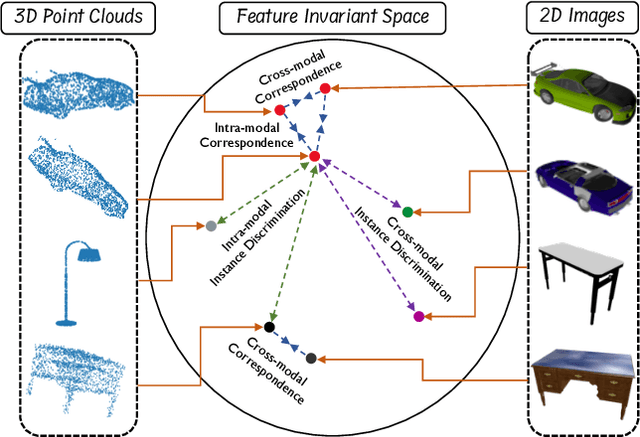
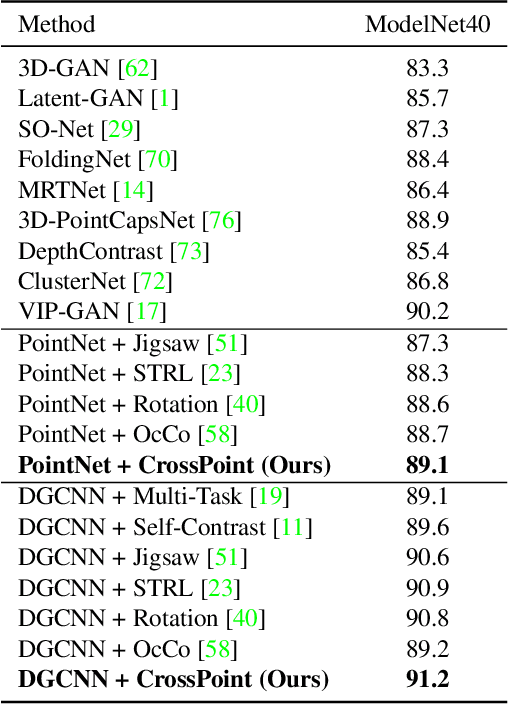
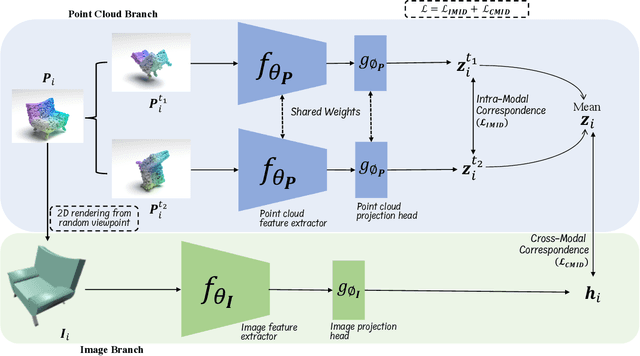
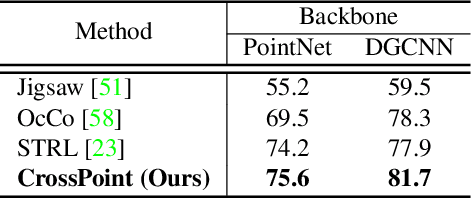
Abstract:Manual annotation of large-scale point cloud dataset for varying tasks such as 3D object classification, segmentation and detection is often laborious owing to the irregular structure of point clouds. Self-supervised learning, which operates without any human labeling, is a promising approach to address this issue. We observe in the real world that humans are capable of mapping the visual concepts learnt from 2D images to understand the 3D world. Encouraged by this insight, we propose CrossPoint, a simple cross-modal contrastive learning approach to learn transferable 3D point cloud representations. It enables a 3D-2D correspondence of objects by maximizing agreement between point clouds and the corresponding rendered 2D image in the invariant space, while encouraging invariance to transformations in the point cloud modality. Our joint training objective combines the feature correspondences within and across modalities, thus ensembles a rich learning signal from both 3D point cloud and 2D image modalities in a self-supervised fashion. Experimental results show that our approach outperforms the previous unsupervised learning methods on a diverse range of downstream tasks including 3D object classification and segmentation. Further, the ablation studies validate the potency of our approach for a better point cloud understanding. Code and pretrained models are available at http://github.com/MohamedAfham/CrossPoint.
Conservative Plane Releasing for Spatial Privacy Protection in Mixed Reality
Apr 17, 2020



Abstract:Augmented reality (AR) or mixed reality (MR) platforms require spatial understanding to detect objects or surfaces, often including their structural (i.e. spatial geometry) and photometric (e.g. color, and texture) attributes, to allow applications to place virtual or synthetic objects seemingly "anchored" on to real world objects; in some cases, even allowing interactions between the physical and virtual objects. These functionalities require AR/MR platforms to capture the 3D spatial information with high resolution and frequency; however, these pose unprecedented risks to user privacy. Aside from objects being detected, spatial information also reveals the location of the user with high specificity, e.g. in which part of the house the user is. In this work, we propose to leverage spatial generalizations coupled with conservative releasing to provide spatial privacy while maintaining data utility. We designed an adversary that builds up on existing place and shape recognition methods over 3D data as attackers to which the proposed spatial privacy approach can be evaluated against. Then, we simulate user movement within spaces which reveals more of their space as they move around utilizing 3D point clouds collected from Microsoft HoloLens. Results show that revealing no more than 11 generalized planes--accumulated from successively revealed spaces with large enough radius, i.e. $r\leq1.0m$--can make an adversary fail in identifying the spatial location of the user for at least half of the time. Furthermore, if the accumulated spaces are of smaller radius, i.e. each successively revealed space is $r\leq 0.5m$, we can release up to 29 generalized planes while enjoying both better data utility and privacy.
Characterizing and Detecting Money Laundering Activities on the Bitcoin Network
Dec 27, 2019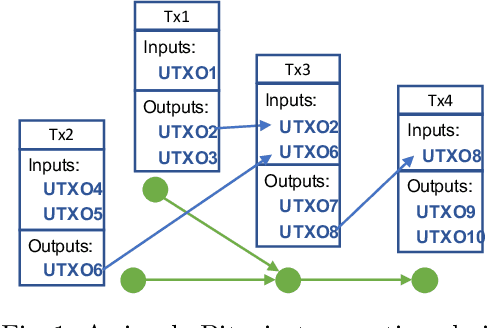

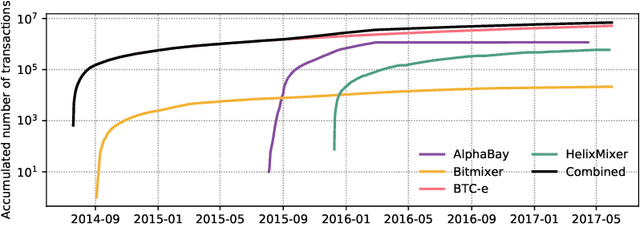

Abstract:Bitcoin is by far the most popular crypto-currency solution enabling peer-to-peer payments. Despite some studies highlighting the network does not provide full anonymity, it is still being heavily used for a wide variety of dubious financial activities such as money laundering, ponzi schemes, and ransom-ware payments. In this paper, we explore the landscape of potential money laundering activities occurring across the Bitcoin network. Using data collected over three years, we create transaction graphs and provide an in-depth analysis on various graph characteristics to differentiate money laundering transactions from regular transactions. We found that the main difference between laundering and regular transactions lies in their output values and neighbourhood information. Then, we propose and evaluate a set of classifiers based on four types of graph features: immediate neighbours, curated features, deepwalk embeddings, and node2vec embeddings to classify money laundering and regular transactions. Results show that the node2vec-based classifier outperforms other classifiers in binary classification reaching an average accuracy of 92.29% and an F1-measure of 0.93 and high robustness over a 2.5-year time span. Finally, we demonstrate how effective our classifiers are in discovering unknown laundering services. The classifier performance dropped compared to binary classification, however, the prediction can be improved with simple ensemble techniques for some services.
 Add to Chrome
Add to Chrome Add to Firefox
Add to Firefox Add to Edge
Add to Edge